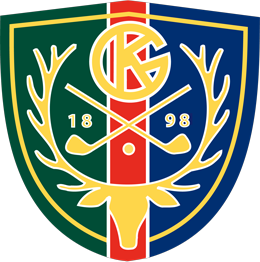We are Scandinavia's first golf club.
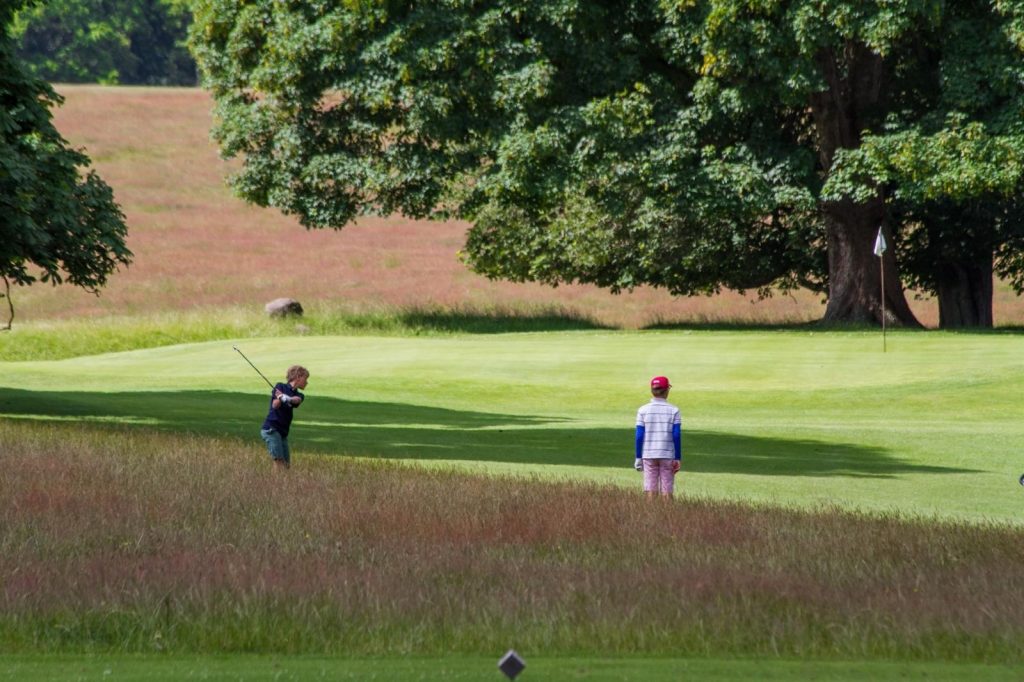
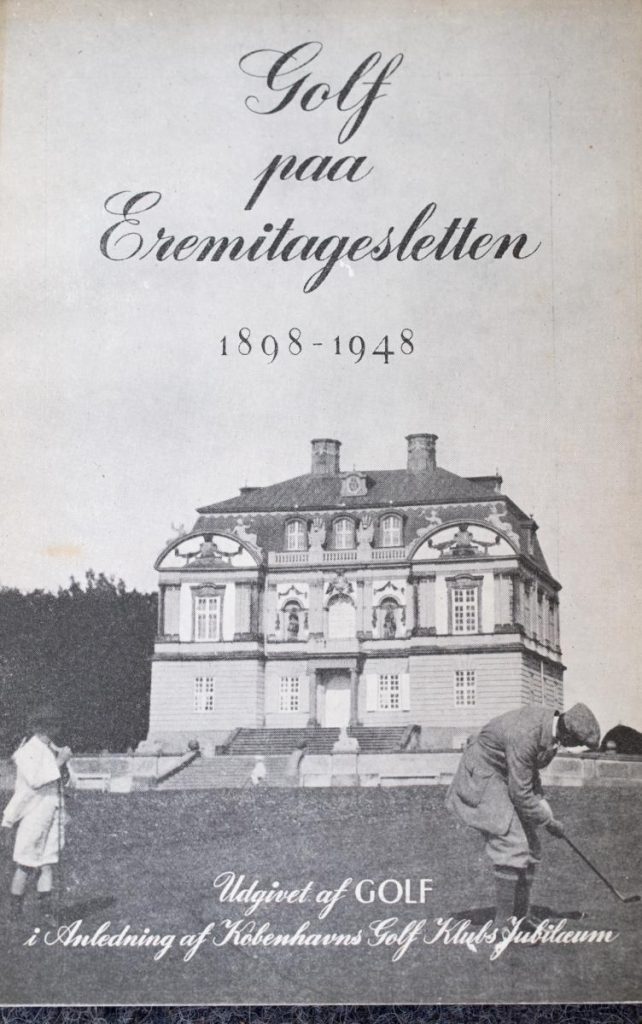

What we are. Who we are.
We are Scandinavia's first golf club located on the unique and historic Eremitageslette. Member or guest, the course is an experience for everyone, gives greater golfing pleasure and keeps you in better shape, because in Dyrehaven we can play all year round. Although close to the city, yet free from noise in the protected area. Enjoy the view from the terrace over the Eremitage and experience golf history in Scandinavia's first golf club, together with family and friends.
The course is designed for a wide range of handicaps, with strategic play as important as aesthetics. It will challenge you at whatever level your golf game is at, while also providing a fantastic natural experience in all seasons.
The encounter with the game of golf can become a lifelong love, balm for the soul, give you good health and expand your social network, because everyone can play against everyone. Golf can be played throughout life, there is a pleasant atmosphere in the club, and friendships are created when you enjoy yourself on the 19th hole terrace after playing and training.
It's fun to start and with the help you receive from members, coaches and secretariat you'll quickly be well underway.
For new members, KGK creates joy and networking. You feel welcome from Day 1, surrounded by kindness and happy people.
The Royal Copenhagen Golf Club
Honorary members
HRH Crown Prince Frederik

HRH Crown Princess Mary
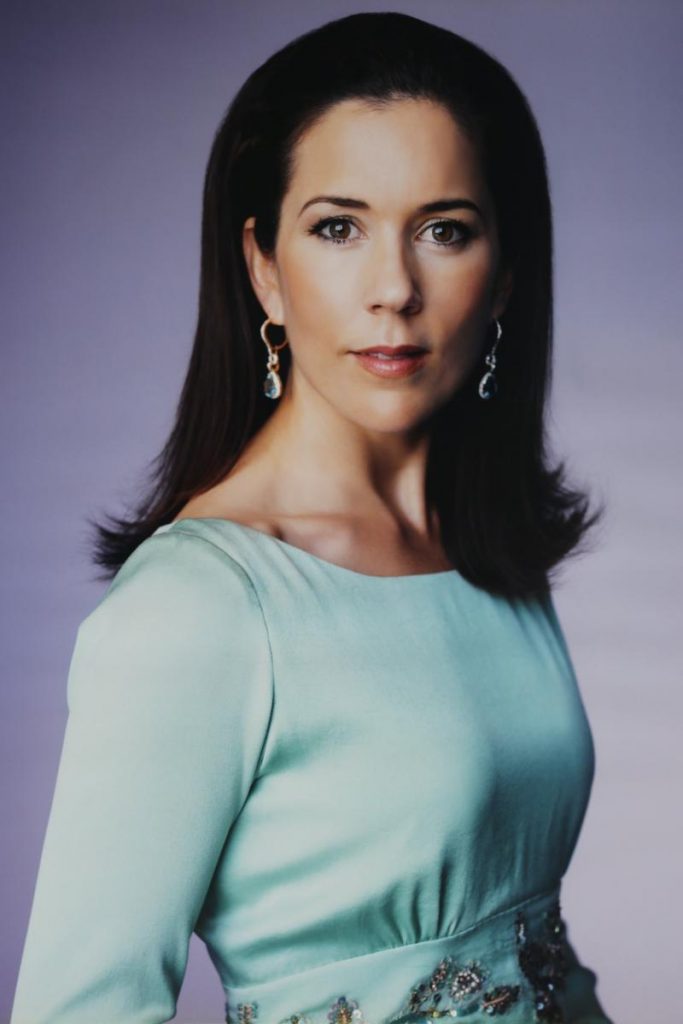
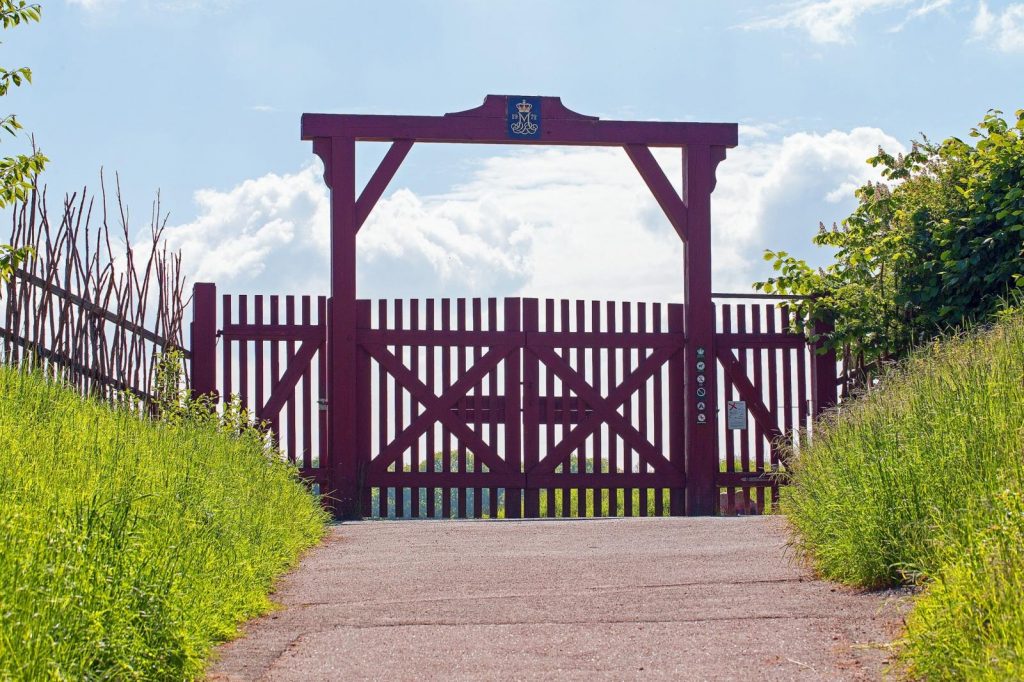
Unesco World Heritage Deer Park
The forests of North Zealand are beautiful nature, but also culture. The forests are built as a stage for the greatest of all hunting forms: the absolute king's parforce hunt.
The landscape for the hunt is created by Christian V in the 1670s and 1680s. The king shows that he tames the wild nature. He puts himself in the scene. He is a great king who rules over both people, animals and nature.
He establishes a system of hunting routes, using the best mathematical sciences of the time. Kilometers of hunting routes are built. They crisscross through Jægersborg Dyrehave and Hegn. The many hunting routes are an enormous amount of work. The king demonstrates here both distinguished engineering and – not least – power and wealth.
The hunting roads make it possible to conduct parforce hunting. A bestial form of hunting by today's standards. But in the 17th century it was very fashionable, not only in Denmark, but throughout Europe. Today the roads are used by many who travel in nature.
The stage is set for the parforce hunt, in which the king plays the leading role. The king invites the people to the hunt. During the hunt, mounted hunters with dogs pursue a selected red deer for hours. The king ends the animal's life. He thrusts a spear or short sword, called a hirschfænger, into the animal's heart.
UNESCO World Heritage covers the entire Parforce Hunting Landscape in North Zealand. The project is paid for by five North Zealand municipalities, the Green Museum and the Nature Boards of the Capital and North Zealand. Museum North Zealand acts as the secretariat. They handle the tasks that must be solved to be a UNESCO World Heritage Site.
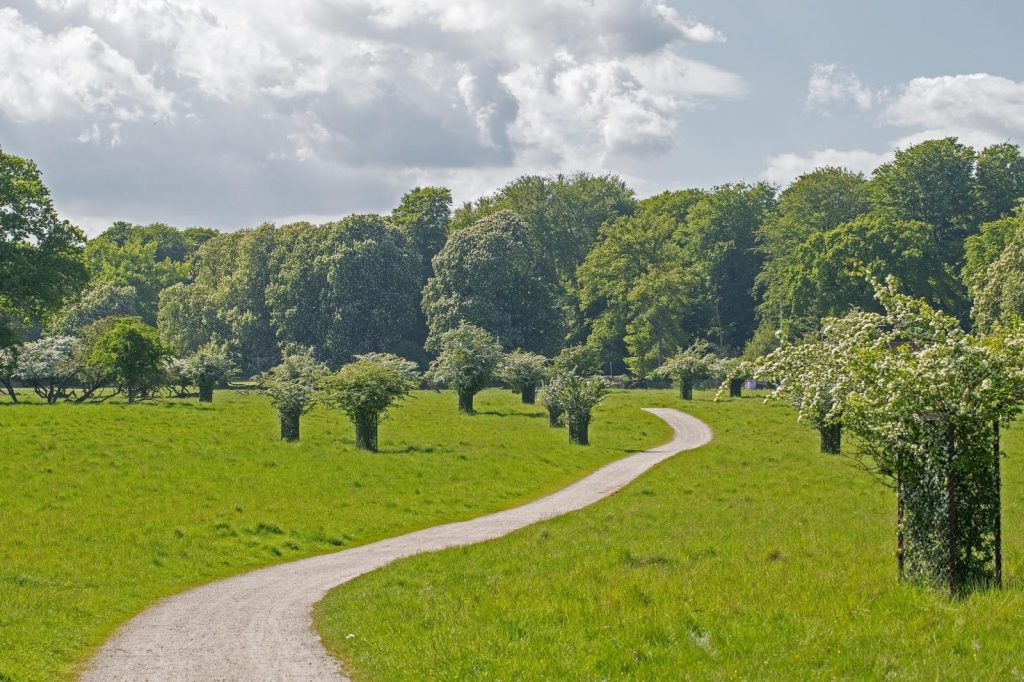
The way we greet each other
When we enter through the red gate to the Deer Park, something happens. We go from noise and din to well-being and the best thoughts. Into this protected area.
On the way we pass each other and say hello.
"By all means, don't lose the desire to walk. I walk every day to my daily well-being and walk away from every illness. I have walked away from my best thoughts, and I know of no thought so heavy that one cannot walk away from it." (Søren Kierkegaard, 1847)
GOLF IS BORN IN DENMARK
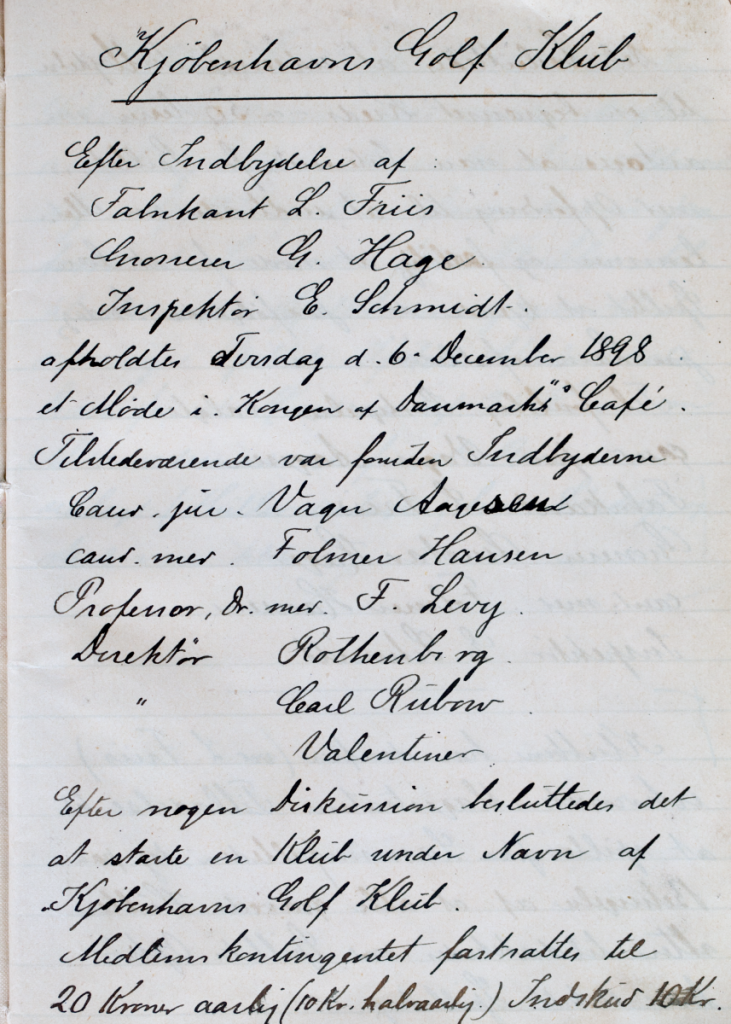
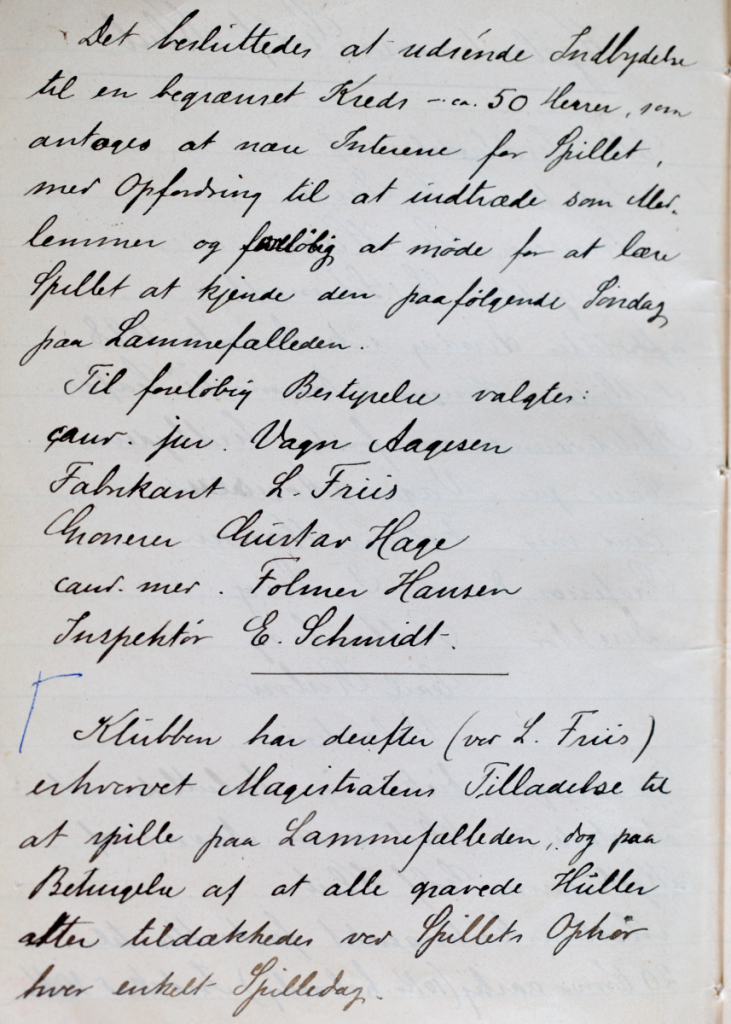
Board minutes for Copenhagen Golf Club 1901
Charles R. Jensen demonstrates golf on Eremitagesletten to a number of guests. Charles recommends that they gather in a club. This becomes the beginning of Scandinavia's first golf club – Copenhagen Golf Club (KGK). The club is formed on December 6, 1898 in Copenhagen.
The KGK archive is lost during the war. One June night in 1944, the clubhouse is bombed by a Schalburgtage group. All material in the clubhouse burns down. A little material outside the clubhouse is saved, including a board minutes.
The board minutes state:
“It was decided to send out an invitation to a limited circle – approximately 50 gentlemen who are assumed to be interested in the game, with an invitation to become members and to meet to learn about the game the following Sunday at Lammefælleden.
The following were elected as provisional board members:
Vagn Aagesen, cand. jur.
Manufacturer L. Friis
Wholesaler Gustav Hage
Master's degree with Folmer Hansen
Inspector E. Schmidt
The club has then (through L. Friis) acquired the Magistrate's permission to play at Lammefælleden, however on condition that all dug holes are covered again at the end of the game each individual game day.
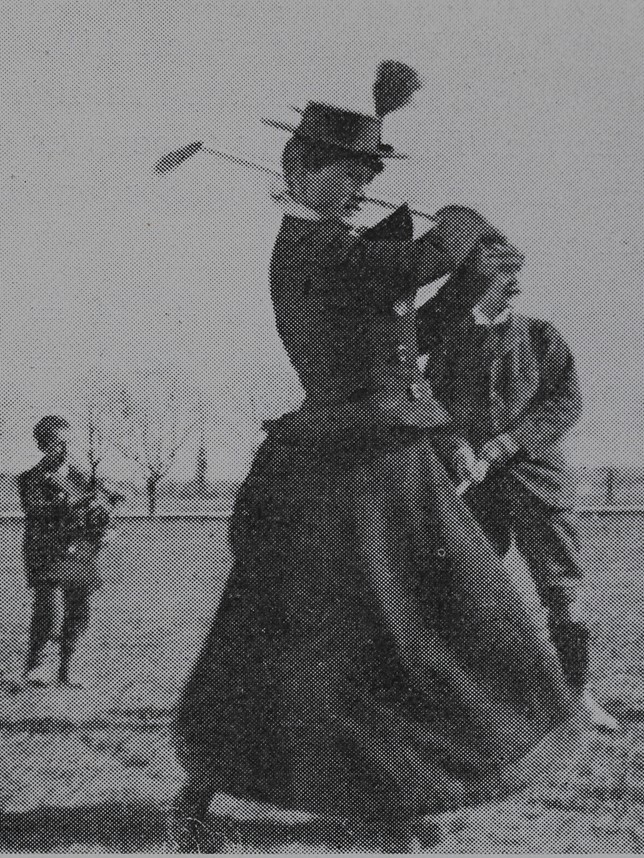
Ingeborg Scavenius wins Denmark's first golf match in 1899
The newspaper Dagens Nyheder writes on Monday, October 10, 1898, about how golf is played: "Golf is played by 2 or more people, each with his own ball - a white ball the size of a small hen's egg. The players also use clubs that have a rather thin cane shaft and end in a bent vertically grooved plate, made of iron or wood, and of different shapes, depending on whether the ball is to be scraped out of a hole or hit from a free spot, whether it is to be hit long or short, etc. An ordinary player can make do with 3 clubs."
The first golf match in Denmark is held by KGK. It is played on Sunday, April 23, 1999, on a course at Lammefælleden. The course has 8 holes and is played through twice. The ladies also participate. Number one is Ingeborg Aagesen, with a total score of 109 strokes. That is approximately 7 strokes per hole. A lady wins the first Danish golf match.
Later that year, matches are played out on Eremitagesletten. The first match on Eremitagesletten is played on an 18-hole course. However, the course is soon changed to a nine-hole course.

Charles R. Jensen demonstrates golf swings on Eremitagesletten 1898
The newspaper "Dagens Nyheder" writes in an article on Monday, October 10, 1898, among other things, the following:
“The man's name is Jensen, he is Danish by birth, expatriated to America, where he learned the game very quickly and trained as a Professional, i.e. Teacher at the Golf Clubs in New York.
Mr. Jensen showed a small group of sportsmen out on the Hermitage Plain how to hit a golf ball. And he did it really nicely. With a quick, agile movement of the wrist, he alternately made the ball fly very considerable distances and slowly sneak down into its hole, and showed how finely and accurately the game can be played.
With regard to playgrounds in the city's vicinity, he believes that Eremitagesletten is the best for now. The commons could probably be used, but as long as the game is new, there won't be enough spectators who would "play along."
He speaks with great skepticism about the future of the game in this country, knowing full well how long it takes before any new sport gains traction. In addition, he intended to stay at home for the time being, especially if he could get students or become a club golf instructor.
So, if anyone wants to learn, now is the time. Henry”
KGK subsequently notes in its board minutes:
"The club has also hired Mr. Charles R. Jensen, who during a several-year stay in America has trained in the game and has, among other things, served as a professional teacher at several clubs, to arrange the playing field and provide instruction in the game. According to the agreement, he must, for a fee of 25 kroner per month, ensure that the course is laid out (holes laid) every Sunday, and must be active…."
The playing field, which is called the pitch, must be large. The holes are dug either in a circle or in a row. Each hole is 5 inches in diameter and 5 inches deep. The distance between the holes is about 400 meters.
Charles R. Jensen becomes Copenhagen Golf Club's first coach and head greenkeeper.
THE OPEN DESIGN
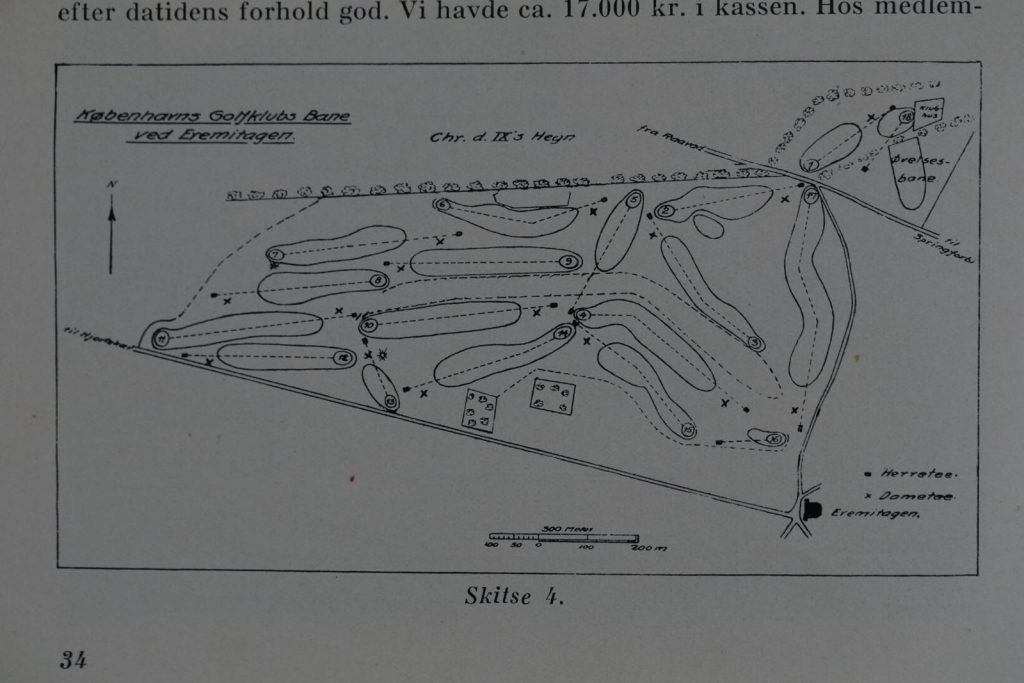
Denmark's first 18-hole golf course
The original drawing of the golf course, showing the course's general layout as it was completed in 1928.
The first playing course is built in Fælledparken in Copenhagen in 1898. It is not a real golf course. It is called a playing course. The course has eight holes and is used for a few months. Every Sunday the same method. You dig out eight holes, and after the game the eight holes are covered over again.
In the autumn of 1898, interest in Eremitagesletten began. For several reasons. The open, gently undulating landscape on Eremitagesletten is suitable for golf. In addition, the grass turf on Eremitagesletten is unique. The king is the reason. He moves the last Stokkerup farmers away in 1670. After that, the grass carpet spreads. Only disturbed by grazing deer and riders on horseback. The deer prevent Eremitagesletten from turning into forest, as they eat the young beech shoots.
In 1899, KGK therefore asked Dyrehaven for permission to play golf on Eremitagesletten. They received word from the forestry department that everyone had access to the plain. This was the start of the first golf course on Eremitagesletten in 1899. The golf course was located in a triangular area: between Eremitageslottet, Hjortekærvej and the road to Fortunen. The club regularly changed the course of the golf courses.
The story of Denmark's first real 18-hole golf course begins in the 1920s. KGK lacks a real 18-hole golf course. Chairman Frederik Hegel proposes building a real 18-hole golf course north of Hjortekærvejen. The area on the northern side of Hjortekærvejen is better suited for a golf course. A more undulating landscape with fewer bumps.
Denmark's first 18-hole golf course was inaugurated on May 4, 1928 on Eremitagesletten.
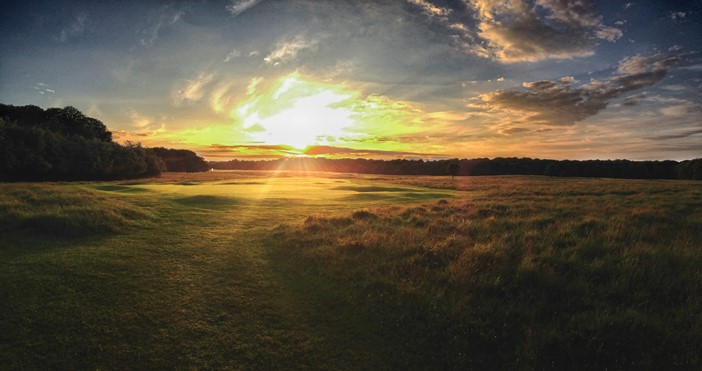
The Open Course Design
KGK wants a course in the classic English style, and contacts a well-known English course architect. The course architect arrives from England in 1926 and designs the course in 14 days. Two years later, Denmark's first 18-hole golf course is ready. The course has narrow fairways, thick rough and firm greens. A style known from The Open Circle golf courses in Great Britain.
The Open design is enhanced during a major restoration of KGK's course. In 2008, KGK contacted Scottish course architect Tom Mackenzie, from the firm Mackenzie & Ebert. The firm is working on seven out of the ten Open Circle courses. Tom is both designing and carrying out the restoration of KGK's golf course on Eremitagesletten. The crew and machinery are the same as Tom uses on The Open courses in Great Britain. The restoration will take place over the two winters of 2008/2009 and 2009/2010.
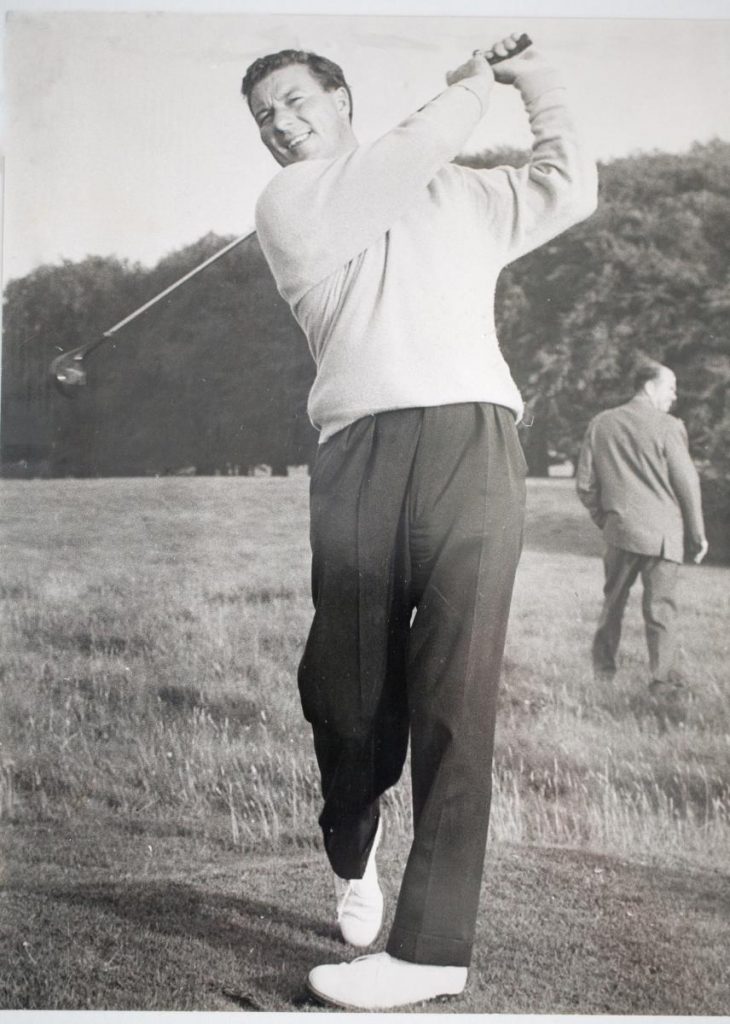
Five-time The Open winner Peter Thomson plays at Eremitagesletten
In the years 1946-1973, Copenhagen Golf Club held a tournament for professionals – Copenhagen Cup.
Famous foreign professional golfers come and play the Copenhagen Cup. They use the tournament as a warm-up for playing The Open later in the summer. The similarity between the golf course at Eremitagesletten and The Open courses gives the same playing style. The Copenhagen Cup is therefore a good warm-up for The Open.
Peter William Thomson is the greatest of these professional golfers. Thomson was born on the outskirts of Melbourne, Australia, in 1929. He won three consecutive Majors in the 20th century. The only golfer ever to do so. The three victories were in 1954, 1955 and 1956. He won The Open twice more in 1958 and 1965. In 1965 he defeated Jack Nicklaus and Arnold Palmer. Thomson qualified for The Open for the last time at the age of 49.
Thomson won ten national championships in his career. He played on the PGA Tour from 1953 to 1954 and again in 1956. He won the Texas International Open in 1956. Thomson also had a successful senior career. He won nine times on the Senior PGA Tour in the United States and finished at the top of the money list. He was inducted into The World Golf Hall of Fame in 1988.
Peter Thomson dies in 2018 at the age of 88, leaving behind four children.
GOLF ON THE HERITAGE PLAIN
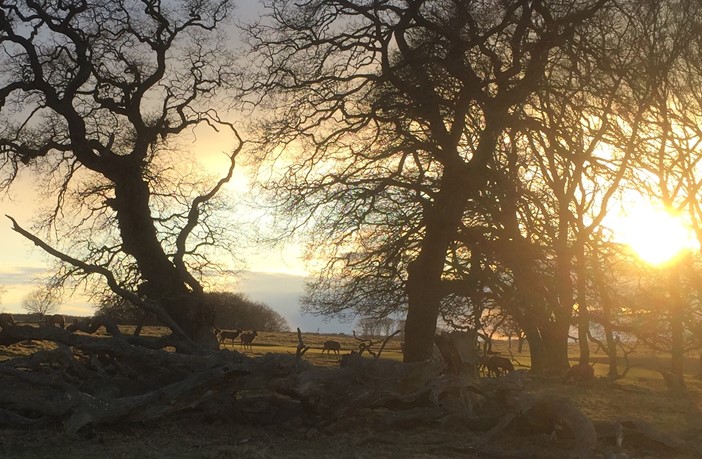
Royal decree: If an oak falls, a new one must be planted.
The park is rich in ancient giant oaks, which over time stand like crooked sculptures. Many of them have been given their own names. The trees can live up to 1000 years if they are given space and sunlight, and they get this not least thanks to the deer that graze freely. Especially under the oaks, which let light pass down to the forest floor. The deer eat the beech shoots that otherwise grow up and over time shade the oaks.
Two of the oldest oak trees stand near the golf course. At the Five-Way Crossing northeast of the Hermitage stands the oak where King Christian V was kicked by a wounded red deer during a parforce hunt in 1698. The king never recovered and died the following year. The oak is named after him and is called Christian V's Oak.
The English oak at the Hermitage was about to die out a couple of hundred years ago. But one of the soldiers who had taken part in the siege of Copenhagen in 1807, where the English, among other things, camped in Dyrehaven, confessed on his deathbed that he had helped kill the regiment's treasurer. They had robbed the chest containing the soldiers' pay and buried it by the characteristic old tree northeast of the Hermitage.
A real treasure hunt began, with digging around the tree, which gave the roots so much air that they began to sprout new shoots. However, the treasure was never found….
Some of the trees were planted in the years after 1669, when the King ordered the planting of 12,000 oaks and beeches in the new deer park. The many oaks have also been preserved because the Deer Park is a pleasure forest by royal decree and was not established with an eye to revenue. This means that the Deer Park's mix of trees must remain the same – if something falls, new ones must be planted in its place.
The royal decree has ensured that the oak trees of Dyrehaven have been preserved, because oak has been in great demand for centuries. That is why 200 years ago 16,000 oak trees were planted all over North Zealand. The background was tragic: In 1806 the English bombarded Copenhagen and subsequently took off with the entire Danish fleet. 90,000 fully grown oak trees were thus lost, because each ship was built from 2,000 oak trees. It was a national catastrophe. Therefore, and with great foresight, the many oak trees were planted so that Denmark would have enough wood for its warships 150 years later.
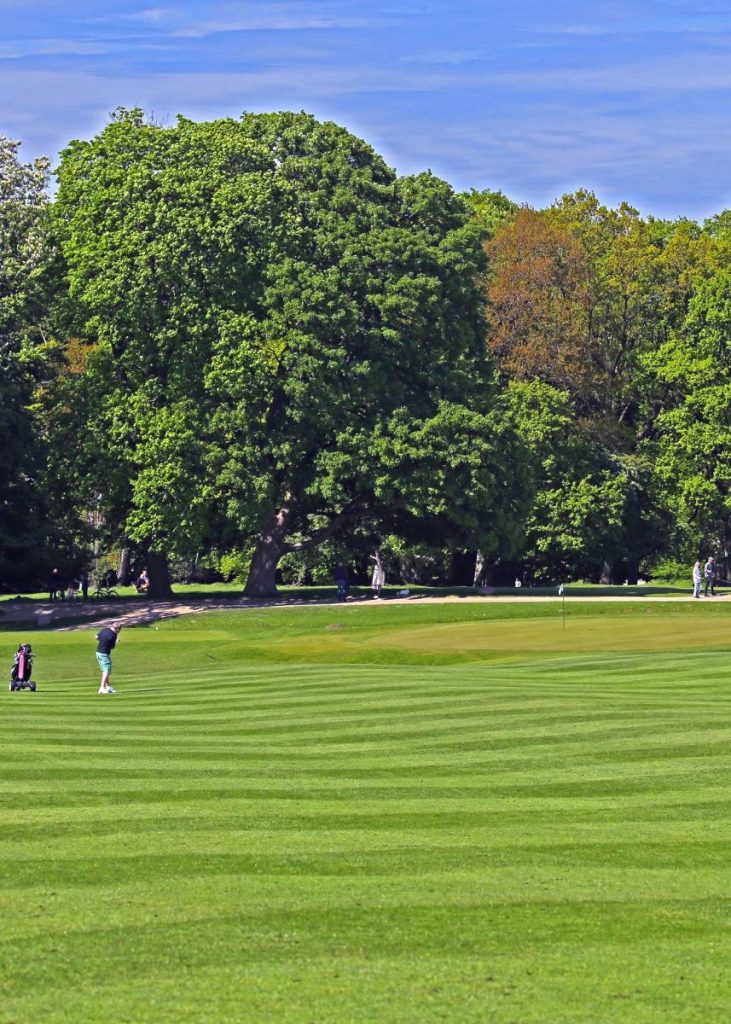
The Stokkerup farmers' raised fields appear
They remove the tubers and cut the grass for the fairway as KGK builds the 18-hole golf course from 1926-1928. The history of Eremitagesletten emerges from the ground. The construction of the golf course conjures up the fields of the Stokkerup farmers.
The high-ridged fields from the time of the Stokkerup farmers come into view. Each farmer has his own field. It is 15-16 meters wide and highest in the middle. The high-ridged fields ensure the harvest in both dry and wet summers. In the dry summers there is little moisture at the bottom of the fields. The plants at the bottom therefore do better. In the wet summers the plants up on the high ridges do best. They avoid being flooded. In this way the Stokkerup farmers protect themselves. Both against drought and against flooding.
The high ridges of two fields are visible when the sun is low over the 17th fairway and green.
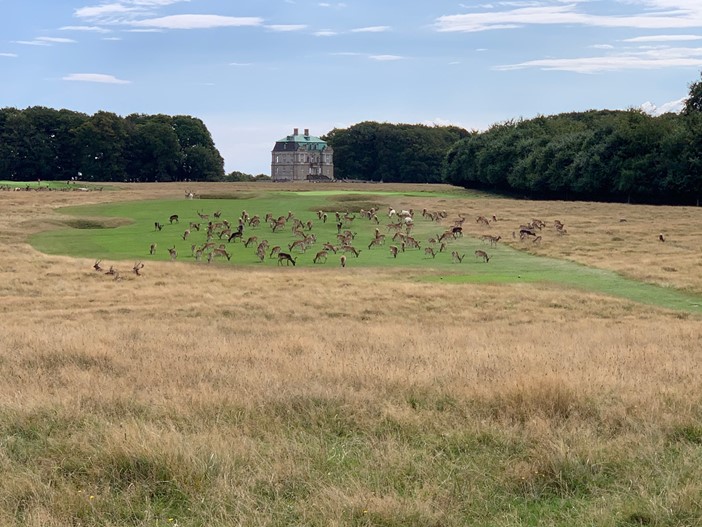
The deer occupy the Hermitage Plain
The red deer arrived in Denmark 10,000 years ago, becoming our largest wild mammal. The male deer measures 140 cm and weighs 230 kg and develops a large antler every year. The female, the hind, is somewhat smaller. The hinds and their calves live mostly in the southern part of the park. The stags in the northern part. They only meet during the rutting season in September and October. The total population is approximately 300 red deer. Many of the surplus are exported. The park's red deer are sought after all over the world. Some graze today in New Zealand.
Red deer are usually dark brown, but we also find white deer in the Deer Park. Christian VI received 12 white deer from Elector August of Saxony in 1737. The white deer we see today are descendants of these. The white population is kept down to 15-20 animals.
Neither the white deer nor the fallow deer at the zoo are albinos. They have grey snouts and muzzles and grey-blue eyes, not red like true albinos. They are a variant of the common red deer.
The fallow deer disappeared from our latitudes during the Ice Age, but was reintroduced as an ornamental animal in the 13th century. The deer can measure 95 cm at the shoulder and weigh 100 kg. The doe is somewhat smaller. Fallow deer can be black, white or brown. Their coat is white with three vertical black stripes that look like the number 111. The fallow deer is in heat from October to November. There are approximately 1600 fallow deer in the Deer Park.
The sika deer originates from eastern Asia and was introduced to the Zoo in 1923. The deer measures up to 80 cm at the shoulder and weighs 50 kg, the doe only 35 kg. The sika deer differs from the fallow deer. It is darker and without the black stripes that form the number 111 in the fallow deer. The rutting season is from September to January. There are approximately 100 sika deer in the Zoo.
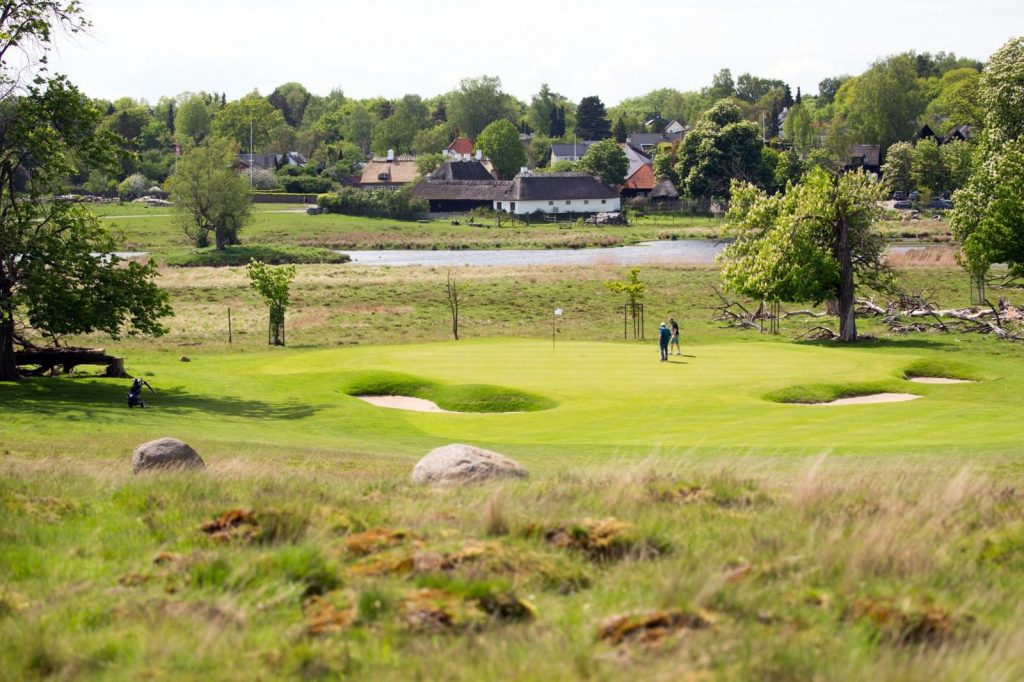
Yellow meadow ants build mounds at the 12th hole
The yellow meadow ant has a yellowish color in the males, hence the name yellow meadow ant. The females are more brownish.
Males are smaller than females. Males measure approximately 2-4mm, while females are over twice as large, measuring 6-8mm. The yellow meadow ant is slightly smaller than a normal ant.
The yellow meadow ant builds its nest in sunny areas. The slope down towards the 12th green suits them well. They rarely come to the surface and live underground unless they are on a mating flight.
The yellow meadow ant can be said to have invented modern agriculture. The yellow meadow ant lives its entire life underground. Down here, it keeps aphids like dairy cattle. The aphids get their food from roots, and secrete a sugary liquid called honeydew. This honeydew eats the yellow meadow ant. A perpetual motion machine in agriculture.
Yellow meadow ants and all the other ant species are cold-blooded. They get all their heat from their surroundings. That's why they keep a low profile throughout the winter. So when it's cold outside, agriculture comes to a standstill.
The ants live about 25,000 in each anthill. If we mark out an area of 5 x 5 meters along the road down to the 12th green, we will find about 20 anthills. We have about 0.5 million yellow meadow ants alone within these 25 square meters.
The world-famous restaurant Noma has had the yellow meadow ant on its menu.
